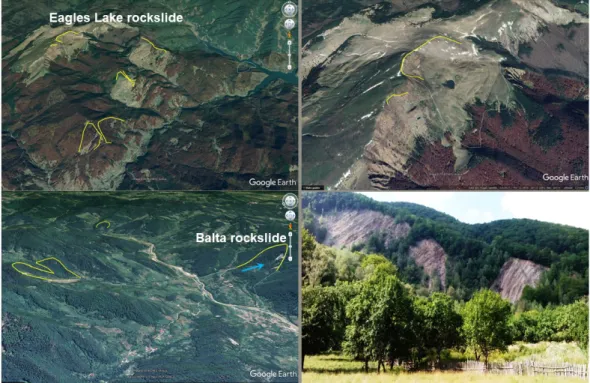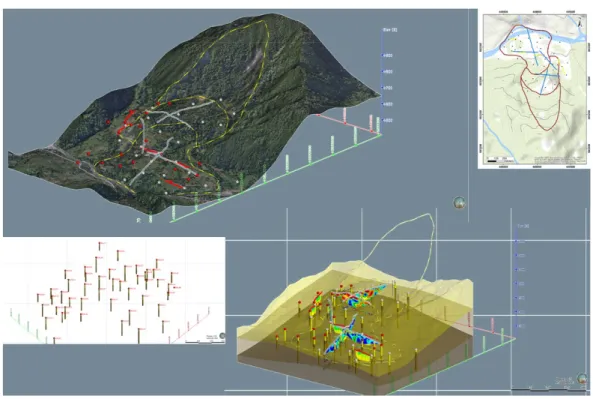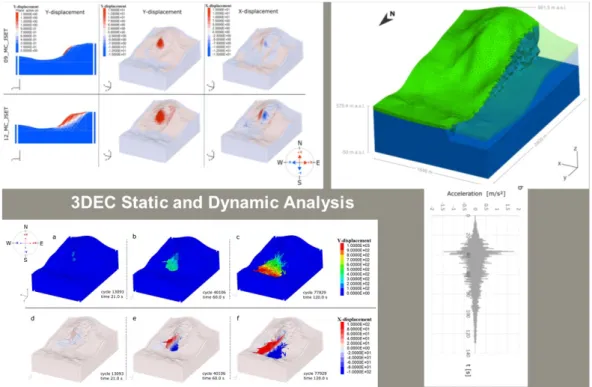2-3D dynamic numerical modelling of
seismically induced rock slope failures
Hans-Balder Havenith, Anne-Sophie Mreyen, Emilie Lemaire
Liege University, Belgium - HB.Havenith@uliege.be
11/22/2020 AGU - iPosterSessions.com
ABSTRACT
The stability of rock slopes is often guided significantly by the structural geology of the rocks composing the slope. In this work, we analyse the influence of structural characteristics, and of their seismic response, on large and deep-seated rock slope failure development. The study is focused on the Tamins and Fernpass rockslides in the European Alps and on the Balta and Eagle’s Lake rockslides in the southeastern Carpathians. These case studies are compared with catastrophic rock slope failures with ascertained or very likely seismic origin in the Tien Shan Mountains. The main goal is to identify indicators for seismically induced rock slope failures based on the source zone rock structures and failure scar geometry. We present examples of failures in anti-dip slopes and along-strike rock structures that were potentially (or partially) caused by seismic triggering, and we also consider a series of mixed structural types, which are more difficult to interpret conclusively. This morpho-structural study is supported by 2D and 3D distinct element numerical models of the Balta site (with reconstructed initial mountain morphology) showing that seismic shaking typically induces deeper-seated deformation in initially ‘stable’ rock slopes. In addition, for failures partially triggered by seismic shaking, these studies can help identify the contribution of the seismic factor to slope instability. The identification of the partial seismic origin on the basis of the dynamic response of rock structures can be particularly interesting for case histories in less seismically active mountain regions (in comparison with the Andes, Tien Shan, Pamirs), such as in the European Alps and the Carpathian Mountains. 3D models were also run to simulate the full rock avalanche process, including the formation of a dam on the valley floor.
ROCKSLIDE SITES
Rockslides were studied in the Alps and Carpathian Mountains (Figures 2 and 3). There is a long record of landslide disasters in historical and recent times in the European Alps, but there are only a few documented cases of larger rockslides triggered by earthquakes (see e.g. cases in Switzerland described by Fritsche et al., 2012, some shown in Figure 2). For instance, in 1348, six landslides (with volumes of 1, 3.5, 8, 15, 20, and 100 mio m ) were triggered in the Dobratsch Mountain (Lenhardt, 2007; Figure 1) by an earthquake in the Friuli region (northern Italy; Prager et al., 2008).
In the eastern Swiss Alps (Grisons region), the ancient Tamins rockslide (see location in Figure 1; more detailed views are shown in the third section) with a volume exceeding around 1.5 km (Abele, 1974) had an unknown trigger but presents some characteristics (deep scarp compared to other rockslides in the Alps, high on the slope, and not clearly undercut by a river) of a mass movement with at least partial seismic influence. This rockslide collapsed from the Sennenstein Mountain and blocked the Rhine Valley. Even though the Tamins rockslide was a very large mass movement, it is far less studied than its “big brother”, the Flims slide that occurred in same area but with an estimated volume of 8–12 km (see e.g. Poschinger 2011).
Figure 2 : Rockslides in the Alps with possible/proved seismic origin.
3
3
11/22/2020 AGU - iPosterSessions.com
3D GEOMODELS
Below structural models of the Tamins and Balta rockslide sites are shown. Figure 4 presents the structural data collected in the field. The following figures present plots of the main structural planes within surface models of the Tamins and Balta (partly also for Eagles Lake) sites.
The last figures (9 and 10) shown below present a geomodel of Balta with geophysical subsurface information that was used to create a full 3D model of the rockslide site and to reconstruct the original site before failure for back-analsysis.
11/22/2020 AGU - iPosterSessions.com
Figure 6 : Representation of the structural data within a 3D surface model (hillshade) of Tamins
Figure 7 : Representation of the structural data within a 3D surface model (with imagery) of Eagles Lake (above) and Balta below
Figure 8 : Structural geomodel of Balta site
2D NUMERICAL ANALYSIS
Below results of 2D and 3D numerical dynamic analyses completed with UDEC and 3DEC (Itasca software) are presented (Figures 11 and 12). As seismic inputs Ricker wavelets and earthquake accelerograms were used.
Figure 11 : 2D parametric numerical dynamic analysis based on the central reconstructed Balta slope section (published in Lemaire et al., 2020).
Figure 12 : 3D numerical dynamic analysis of the seismically induced response and failure of the reconstructed Balta slope site.
11/22/2020 AGU - iPosterSessions.com
CONCLUSION-REFERENCES-ACKNOWLEDGEMENTS
This poster presents structural geology information for several rockslides which display some characteristics of seismic triggering: they present a very deep scarp high on the slope, do not appear to have been influenced by river undercutting, and seem to have been formed in a statically stable condition. The motivation of this study was the expectation that certain rock structures can have a strong influence on slope stability and may be more or less susceptible to seismically induced failures. The Balta rockslide in Romania is the prime example of an ancient, massive slope failure whose origin is unknown but for which a seismic origin is very likely since that site is composed of an initially stable bedding structure, dipping into the slope with 35° to 50°, locally including very thick (>5 m) sandstone beds. Similar observations were made for the Eagle’s Lake rockslide. For the Tamins rockslide source zone, a mixed situation can be observed, as rocks outcropping in the lateral parts of the scarp are not favouring massive slope failure (dip orientation very
oblique to the sliding direction), whereas the central zone is marked by the presence of rock layers dipping in the same direction as the sliding movement (towards the south). We concluded that if ever seismic shaking had been involved in the trigger processes of this ancient rockslide, it will be almost impossible to prove it.
Finally, we did not present any detailed results for the Fernpass rock avalanche (Austria), but first structural analyses (published by Lemaire et al., 2020) indicate that this massive failure (much younger than Tamins) marked by along-strike failure (like the Daguanbao rockslide triggered by the Wenchuan earthquake in 2008) might indeed have been (at least partly) induced by seismic shaking. Other factors (such as the rockslide cluster of similar age nearby) also hint at a seismic influence.
For the Balta rockslide also a full 3D geomodel (based on geophysical data), and 2D and 3D numerical models were created. They confirm the relatively high static stability of the back-analysed (reconstructed) slope site - but massive failure could be simulated after introduction of an earthquake input (Friuli 1976 accelerogram, with PGA max of 0.2g) at the model basis and vertical upward propagation of the seismic shaking.
References
Abele, G. Bergstürze in den Alpen: Ihre Verbreitung, Morphologie und Folgeerscheinungen. In Wissenschaftliche Alpenvereinshefte; Dt. Alpenverein, Ed. 1974.
Fritsche, S.; Fäh, D.; Schwarz-Zanetti, G. Historical intensity VIII earthquakes along the Rhone valley (Valais, Switzerland): Primary and secondary effects. Swiss J. Geosci. 2012, 105, pp. 1–18.
Lemaire, E.; Mreyen, A.-S.; Dufresne, A.; Havenith, H.-B. Analysis of the Influence of Structural Geology on the Massive Seismic Slope Failure Potential Supported by Numerical Modelling. Geosciences 2020, 10, 323, pp. 1-30.
Lenhardt, W. Earthquake-triggered landslides in Austria–Dobratsch revisited. Jahrb. Geol. Bundesanst. 2007, 147, pp. 193–199.
Poschinger, A.V. The Flims Rockslide Dam. In Natural and Artificial Rockslide Dams; Evans, S.G., Hermanns, R.L., Strom, A., Scarascia-Mugnozza, G., Eds.; Springer: Berlin/Heidelberg, Germany, 2011;
pp. 407–421.
Prager, C.; Zangerl, C.; Patzelt, G.; Brandner, R. Age distribution of fossil landslides in the Tyrol (Austria) and its surrounding areas. Nat. Hazards Earth Syst. Sci. 2008, 8, pp. 377–407.
Acknowledgements
We thank Dr. Mihai Micu, from Romania (Inst. Geography), for the support in the structural geological mapping and geophysical surveys in 2016-2019 in the Romanian Carpathian Mountains. We also thank Dr. Anja Dufresne (RWTH Aachen, Germany) for contributions to the structural analyses.
AUTHOR INFORMATION
For questions: HB.Havenith@uliege.be ; or contact Anne-Sophie Mreyen - as.mreyen@uliege.be see also : https://www.researchgate.net/profile/Hans_Balder_Havenith
11/22/2020 AGU - iPosterSessions.com
ABSTRACT
The stability of rock slopes is often guided significantly by the structural geology of the rocks composing the slope. In this work, we analyse the influence of structural characteristics, and of their seismic response, on large and deep-seated rock slope failure development. The study is focused on the Tamins and Fernpass rockslides in the European Alps and on the Balta and Eagle’s Lake rockslides in the southeastern Carpathians. These case studies are compared with catastrophic rock slope failures with ascertained or very likely seismic origin in the Tien Shan Mountains. The main goal is to identify indicators for seismically induced rock slope failures based on the source zone rock structures and failure scar geometry. We present examples of failures in anti-dip slopes and along-strike rock structures that were potentially (or partially) caused by seismic triggering, and we also consider a series of mixed structural types, which are more difficult to interpret conclusively. This morpho-structural study is supported by 2D and 3D distinct element numerical models of the Balta site (with reconstructed initial mountain morphology) showing that seismic shaking typically induces deeper-seated deformation in initially ‘stable’ rock slopes. In addition, for failures partially triggered by seismic shaking, these studies can help identify the contribution of the seismic factor to slope instability. The identification of the partial seismic origin on the basis of the dynamic response of rock structures can be particularly interesting for case histories in less seismically active mountain regions (in comparison with the Andes, Tien Shan, Pamirs), such as in the European Alps and the Carpathian Mountains. 3D models were also run to simulate the full rock avalanche process, including the formation of a dam on the valley floor.




